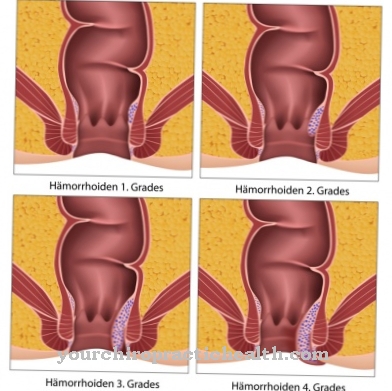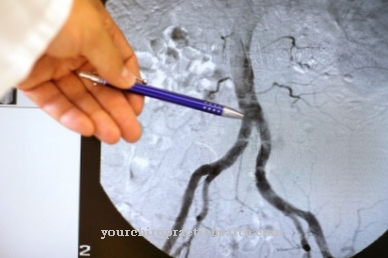In any case, pathological changes in the skin usually result in those affected suffering psychologically and having to experience a significant impairment of their quality of life. Nevertheless, the options of treatments are also available at the Scleroderma quite cheap.
What is scleroderma

© Popmarleo - stock.adobe.com
The Scleroderma, properly progressive systemic scleroderma is a skin disease that is one of the autoimmune diseases. In the processes that take place within scleroderma, the collagen connective tissue, which is so important for the skin, is particularly affected.
So-called sclerosis of the supporting tissue, which is elastic to a certain extent, occurs. For this reason, scleroderma is a collagen disease. This means that scleroderma is assigned to the rheumatic systemic diseases of the blood vessels and connective tissue, which are chronic and characterized by inflammatory processes.
Scleroderma is also known by other synonyms such as systemic sclerosis, diffuse or systemic scleroderma. More women than men suffer from scleroderma.
causes
On what the emergence of the Scleroderma is based, has not yet been clarified.
Only direct connections between progressive systemic scleroderma and overreactions or malfunctions in the body's own defense system are assumed. This fact makes it difficult to find a causal therapy for scleroderma.
Intensive scientific research has shown that the cell components of the connective tissue involved in scleroderma do not function properly, which leads to malformations of the collagenous tissue.
In this context, overproduction of collagen occurs in scleroderma, which contributes to hardening and the loss of elasticity in the skin. The extreme concentration of collagen in progressive systemic scleroderma causes fibrosis.
Symptoms, ailments & signs
Scleroderma usually appears as attacks of circulatory disorders in the hands and feet. This Raynaud phenomenon is associated with a noticeable pallor as well as pain and / or numbness. If these circulatory disorders persist for a long time, the small blood vessels in the fingers and toes are permanently damaged.
The skin becomes inflamed and the fingers, feet, lower legs and toes swell. Over time, the skin hardens and thickens. Because of these changes and poor blood circulation, it is very pale and waxy in appearance. The hardening of the skin means that patients can no longer move their joints properly.
In particularly severe cases of the disease, there is a loss of subcutaneous fatty tissue. This makes the fingers appear pointed and narrow. These Madonna fingers are associated with a loss or impairment of fine motor skills. At this stage, people with scleroderma find it difficult to tie their shoes or button up a shirt.
The skin on the tips of the fingers with poor blood circulation can die off. This causes small painful wounds, so-called rat bite necrosis. Since the skin on the face is also affected by the changes, the facial expressions of the patients change. You can no longer open your mouth properly and have difficulty ingesting food.
Diagnosis & course
As a consequence of the fibrosis manifesting in the skin, the connective tissue layers develop in the Scleroderma fixed areas. In scleroderma, these contribute to the fact that the blood vessels can no longer expand sufficiently and thus an undersupply of the surrounding tissue is favored. Scleroderma also scars the skin.
The course of progressive systemic scleroderma is characterized by acral limiting or diffuse progression. The treatment depends on the skin changes that occur.
There are various methods available to medical professionals for the targeted diagnosis of scleroderma. In addition to the classic clinical appearances, it is the examinations of skin tissue and a determination of the body's own antibodies and the rate of sedimentation in order to detect scleroderma.
Complications
The complications of scleroderma are based on the type of disease and the involvement of the internal organs. The circumscribed scleroderma, for example, is not life-threatening. If the disease affects the lungs, however, pulmonary hypertension can occur, which in the further course is associated with serious complications and in certain circumstances even leads to the death of the patient.
Occasionally the typical edema becomes inflamed and scars or lumps develop. Usually a so-called secondary Raynaud's syndrome also forms, in which the skin areas become pale and the fingertips become scarred. In the worst case, the tissue can even die. The skin tension on the face leads to so-called mimic rigidity, which is associated with premature wrinkling and skin irritation.
In some cases, the skin changes permanently and pigment disorders occur. In the later stages of the disease, joint inflammation, difficulty swallowing and pulmonary fibrosis occur. All of these complaints are associated with further complications.
The treatment itself is usually risk-free. Complications can occur, for example, from the prescribed medication, as part of occupational therapy or acupuncture. A recurrence of scleroderma after the end of treatment cannot be ruled out either.
When should you go to the doctor?
Scleroderma should always be treated by a doctor. Without treatment, the affected person's quality of life is significantly reduced, so that treatment should be carried out as soon as the first complaints and symptoms of scleroderma occur. A doctor should be consulted in scleroderma if the person concerned suffers from severe blood circulation disorders. As a rule, numbness occurs, so that normal movement is no longer easily possible.
In many cases, permanent paleness or severe swelling of the hands can indicate scleroderma and should be examined if it persists for a long time and does not go away on its own. In many cases, those affected can no longer carry out activities with their fingers and hands without discomfort.
In the case of scleroderma, a general practitioner or an orthopedist can primarily be seen. Further treatment is usually carried out by a specialist and is based on the exact characteristics of the symptoms. As a rule, the life expectancy of the person affected is not reduced by scleroderma.
Treatment & Therapy
For the treatment of progressives systematic Scleroderma include selected procedures that are usually not new. In principle, scleroderma cannot be cured.
However, since numerous physical complaints arise as a result of the progression of scleroderma, the treatment is primarily aimed at improving the quality of life. The focus of all therapy concepts against scleroderma is maintaining mobility. For this reason, in addition to special physiotherapy and occupational therapy, so-called physical treatments are also the focus of the treatment.
Since those affected suffer greatly, thermal therapy applications should bring relief. Of course, these procedures as well as massages and, as an alternative, acupuncture for scleroderma are supported by active pharmaceutical ingredients.
Scleroderma not only brings with it persistent symptoms and intense health restrictions. Scleroderma is also known to have complications. These are represented by the intake of immunosuppressants, preparations containing acetylsalicylic acid to promote blood circulation, as well as ACE inhibitors and glucocorticoids.
You can find your medication here
➔ Medicines against edema and water retentionprevention
An actual prevention against the occurrence of the progressive systemic Scleroderma is not given up to now. A worsening of symptoms and possible risks can only be reduced through extensive professional support and care during scleroderma.
In this context, prophylaxis includes continuous monitoring of vital functions, regular skin care and monitoring, proper eye care and avoidance of nicotine and alcohol. Long-term applications, which have already been described in the context of the available treatments and are extremely useful, also help against worsening scleroderma.
Aftercare
As a rule, the measures or the options for follow-up care for scleroderma are significantly limited or are not available to the person affected. They are primarily dependent on a quick and, above all, an early diagnosis of this disease, so that there are no complications or further spread of the tumor in the further course.
As a rule, this disease cannot heal itself. The treatment depends heavily on the severity of the scleroderma, so that no general course can be predicted. In most cases, however, the patients are dependent on the intake of various medications, always paying attention to the correct dosage and regular intake.
If anything is unclear or if there are side effects, a doctor should always be consulted first. During treatment, regular check-ups and examinations by a doctor are usually very important in order to determine further damage to the internal organs. Most patients also need family support and help during treatment. In some cases, scleroderma also reduces the life expectancy of those affected.
You can do that yourself
In order not to cause any deterioration in the skin's appearance or health, the person affected should discuss the use of cosmetic items such as creams or lotions with the attending physician. There may be ingredients in the care products that lead to an increase in symptoms. It is therefore advisable to check the ingredients used before using cosmetics.
The symptoms of the disease include physical complaints that are perceived as difficult, especially in everyday life. Physiotherapy training is therefore offered in a therapy plan that has been developed. Even outside of the treatments, the person affected can carry out the exercises they have learned independently and on their own responsibility. This helps and supports the body in improving the overall situation. It also promotes mobility and prevents possible deterioration.
Since this disease does not heal itself and alternative healing methods are not sufficient, it is particularly important to work with a doctor. Regular skin care and observation of skin changes are recommended. To promote blood circulation, care should be taken to ensure that food intake is optimized for the bloodstream. In addition, rigid postures should be avoided as they can impede blood flow. In everyday life, balancing movements of the limbs must be carried out. As soon as there is a tingling sensation on the skin, the body position should be changed.



























